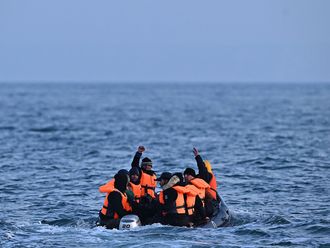
Geneva: The United Nations on Tuesday said 2 million people have fled Ukraine since Russian attacks nearly two weeks ago, a staggering total highlighting a situation described by Ukrainian and world leaders as a humanitarian catastrophe.
UN High Commissioner for Refugees Filippo Grandi recently said the conflict in Ukraine represents “the fastest growing refugee crisis in Europe since World War II.”
Since a Sunday tweet from Grandi that noted how more than 1.5 million people had crossed into neighbouring countries, about 500,000 more people have reportedly fled the country at a time when Ukraine has accused Russia of shelling evacuation routes for civilians.
“Today the outflow of refugees from Ukraine reaches two million people,” he tweeted on Tuesday. Grandi repeated the distressing figure: “Two million.”
Half of the 2 million Ukrainian refugees are children, according to Unicef. The UN is estimating that as many as 4 million people may flee Ukraine - roughly 10% of the Ukrainian population.
The ongoing refugee crisis comes as Ukraine has accused Moscow of shelling humanitarian corridors for four consecutive days. Ukrainian President Volodymyr Zelensky on Monday accused Russian soldiers of being “war criminals,” which Moscow has denied. Ukraine’s foreign ministry on Tuesday cited reports of Russian forces hitting an evacuation route out of hard-hit port city of Mariupol in southern Ukraine.
![refugees]-2-1646754828634](https://imagevars.gulfnews.com/2022/03/08/refugees--2-1646754828634_17f6a3c919d_original-ratio.jpg)
“Ceasefire violated!” the foreign ministry tweeted. “Pressure on Russia MUST step up to make it uphold its commitments.”
Russia announced on Tuesday that it was opening humanitarian corridors to evacuate civilians from cities including Mariupol and the capital, Kyiv. While Russian officials said that evacuees from Kyiv would be flown to Russia after arriving in Gomel, Belarus, officials in Ukraine have rejected the idea of evacuation corridors leading to Russia or its ally, Belarus.
Ukraine said on Tuesday that the only routes on which there is agreement were for regions inside the country. Officials in the city of Sumy said that the first buses of evacuees had left from left for the Ukrainian city of Poltava.
Truce to restore basic services
Besieged areas of Ukraine have sought the ceasefire to restore basic services such as electricity, heat and tap water. As Ukraine has accused Russia of blocking routes and shelling the cities, local officials such as Mariupol Mayor Vadym Boychenko have warned of a humanitarian catastrophe for those who remain in battered areas surrounded by Russian forces.
So far, data shows most of the 2,011,312 Ukrainian refugees have sought refuge in neighboring countries, including more than 1.2 million in Poland alone. Hundreds of thousands of Ukrainians have fled to other European countries such as Hungary and Slovakia. Nearly 100,000 people have fled to Russia as of Tuesday, according to the UN.
The European Union has enacted unprecedented measures to help those fleeing Ukraine. Under rules announced last week, Ukrainian nationals will be offered temporary protection anywhere within the 27-country bloc for up to three years, depending on conditions. They will have the right to live, study and work within the EU.
“All those fleeing Putin’s bombs are welcome in Europe,” European Commission President Ursula von der Leyen said in a statement last week. “We will provide protection to those seeking shelter and we will help those looking for a safe way home.”

The rules, known as “Temporary Protection,” allow Ukrainians to bypass the normal asylum system - a system that has left migrants from elsewhere, particularly Africa and the Middle East, in years-long limbo after arrival.
Though Europe appears united in its desire to help Ukrainians, the welcoming tone has led to questions about why the same set of rules were not used to assist fleeing Afghans, among others.
The grim milestone of 2 million people fleeing Ukraine is also a sad reminder of another humanitarian crisis from years earlier. In 2015 and 2016, roughly 2 million people, including many Syrians fleeing war, sought refuge in Europe. Though some were initially welcomed - in Germany, for instance - sentiment has hardened in the years since, particularly in Eastern Europe.
Now, some of those same governments are opening their doors.
On Monday, Grandi said the outflow of Ukrainians illustrates the need for a “more structured system” for the distribution of refugees in Europe and elsewhere. The European Union has enacted unprecedented measures allowing Ukrainian refugees to live, study and work anywhere within the EU for at least a year.
“This is where we need a more structured system in the EU and certainly beyond the EU [for] ... how to share this responsibility,” Grandi said, pointing to Britain, the United States, Canada and other nations. “I do hope that this, in the end, is the silver lining of this crisis, that Europe understands that any country can become [a] recipient of large numbers of refugees and need the help of others.”
Yet, the rapidly increasing refugee crisis with such a high scale is concerning to James Elder, a spokesman for UNICEF. UNICEF says it is working to provide vital humanitarian supplies, and reach vulnerable Ukrainians with essential services, including health, protection and water.
After saying 1 million of the 2 million Ukrainians fleeing the country are children, Elder on Tuesday acknowledged the deep impact the refugee crisis is having on children in Ukraine.
“A dark historical first,” he tweeted.












